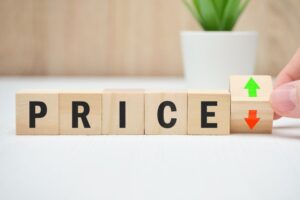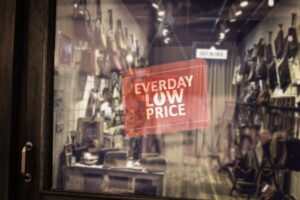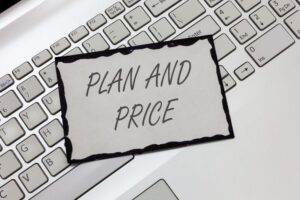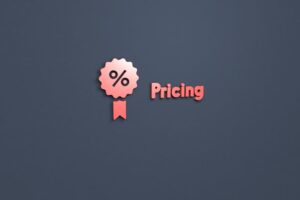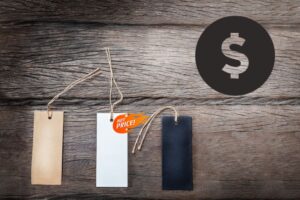Loss Leader Pricing Definition
Loss leader pricing is a strategy that allows business owners to sell products below their market cost to attract customers. The goal is usually to entice customers into a store or a particular brand with the hope that they will purchase other products and services while they are there.
According to a survey, consumers in the United States spent an average of $150 per month on impulse purchases in 2023.
Impulse buying usually occurs when individuals feel they are getting a great deal for their unplanned purchases. This is especially true in the case of a loss leader pricing strategy. However, it was often for the greater good or profits in cases where it has worked.
One typical example of loss leader pricing is when a grocery store sells a gallon of milk for less than it costs to make it.
The store may lose money on every gallon sold, but that’s okay because if customers buy it, they’ll probably buy bread, eggs, and cereal, which have a higher profit margin.
The loss incurred on the discounted items is seen as an investment in gaining customer loyalty and increasing sales.

MORE: What is economy pricing?
Loss Leader Pricing Approaches
Product-Specific Loss Leaders
This strategy involves selecting specific products or services to sell at a discounted price. These products serve as bait to entice visitors to the store or the website.
There’s always a chance that if you enter a supermarket to buy a product, impulsive shopping or happiness from an initially fantastic deal may kick in, and you’ll wind up buying two more products on your way out at regular prices.
Seasonal or Holiday Loss Leaders
Businesses may provide discounts on products that are especially popular during certain seasons or holidays. By capitalizing on increasing demand, they can increase traffic and sales of complementary items.
Bundled Pricing
Bundle pricing involves offering various products or services at a discounted fee. Customers are drawn to the perceived value of receiving more for their money, resulting in greater sales volume and income.
New Product Launches
To generate hype and attract early adopters, businesses may offer a new product or service at a discounted price when it first launches.
While this may result in initial losses, it can increase long-term sales and client loyalty. This allows prospective customers to try the product at a lesser cost before committing to a longer-term purchase.
Membership or Loyalty Program Loss Leaders
Businesses with membership programs may offer members loss leaders through exclusive discounts or promotions. This fosters repeat business and boost client loyalty, ultimately increasing overall revenues.
Clearance or Overstock Loss Leaders
Businesses may reduce excess inventory or old products to make room for new merchandise. While these things are sold at a loss, they help to reduce storage costs and recuperate some of the initial investment.
MORE: What is price positioning
Loss Leader Pricing Examples
Tech Retailers
Electronic retailers typically advertise popular video game consoles at a lower price, even if this means selling them at a loss. Retailers do this in the hopes that customers will purchase more accessories, games, or warranties with higher profit margins.
Similarly, a tech store may offer a limited-time discount on the latest smartphones to entice customers, knowing they will most likely purchase other tech gadgets or accessories during their visit.
Gillette (Razors)
Gillette is famous for providing razors at a budget-friendly price or even offering them for free through their subscription service.
Gillette sells razors at a loss to keep customers hooked on their products and make consistent profits from selling razor blade refills, which are more profitable.
Amazon (Kindle)
Amazon offers its Kindle e-readers at affordable prices, occasionally even below their production costs. The goal is to encourage customers to buy e-books from the Amazon Kindle store, with higher profit margins.
In addition, Kindle devices also offer access to other Amazon services, such as Prime Video and Audible, which can increase customer engagement and generate more revenue.
While there may be an immediate loss on certain items, the long-term gains in terms of client acquisition, retention, and improved sales volume usually outweigh the initial expenses.
MORE: Everyday low pricing
Benefits of Loss Leader Pricing
Customer Acquisition
By offering loss leader deals that appeal to your target audience, you can attract potential customers who were previously unaware of your brand or offerings.
This generates immediate sales and lays the groundwork for long-term customer relationships and loyalty.
Brand Loyalty
Depending on a company’s brand positioning, providing value at a low cost can help to increase customer loyalty. Customers will return if they know that the prices at a specific store will be lower than the competition’s and if that is important to them.
Effective Management of Inventory and Turnover
Loss leader pricing can help manage inventory and increase sales when used strategically.
Businesses can clear out surplus inventory, make place for new merchandise, and attract customers by offering discounts on slow-moving or seasonal items. This helps reduce carrying costs and avoid inventory becoming outdated.
MORE: Market-based pricing
Drawbacks of Loss Leader Pricing
Perception of low-value
Frequent use of loss leader pricing might unintentionally communicate the notion that a company’s products or services are of inferior value.
Customers can also grow accustomed to expecting discounts or promotions, which causes them to mistrust the quality or integrity of the offers at regular rates. This view can be difficult to dispel, and it may harm the brand’s image in the long term.
Cherry-picking by customers
One of the primary downsides of loss leader pricing is the danger that buyers may only buy cheaper items while neglecting higher-margin products.
This behavior is known as cherry-picking and can result in lower profitability and weaken the pricing strategy’s effectiveness.
For example, a supermarket store may run a loss leader campaign on bananas, offering them at a large discount. While customers rush to get the reduced bananas, they may skip other items with better profit margins, resulting in lower overall sales income for the business.
Margin Erosion
Selling products at a loss or below their usual price can reduce profit margins and influence overall profitability, especially if the sales volume of complementary products is too little to balance the losses incurred on the loss leader items.
Overreliance on loss-leader pricing can result in unsustainable business practices and financial instability.
Competitive Pressure and Price Wars
Implementing loss leader pricing can spark competitive responses from competitors, resulting in price wars and downward pressure on profit margins across the sector.
This can lead to a race to the bottom in which businesses constantly undercut each other’s pricing to gain customers, reducing profitability for all parties involved.
Effects on small businesses
Large retailers with substantial financial resources might be more able to handle the losses brought on by loss leader pricing than smaller companies.
Aggressive discounting and price wars can significantly harm smaller rivals, resulting in market division and less competition.
MORE: Usage-based pricing
Is Loss Leader Pricing Good for My Business?
Loss leader pricing can benefit your business depending on various factors, including your industry, target market, competition, and financial situation.
Here are some factors to consider when deciding if your business should adopt this strategy;
1. Market Positioning
Loss leader pricing might work for your company if you’re trying to win over budget-conscious consumers or get an edge over the competition by providing cheaper prices.
On the other hand, discounting might water down your brand’s reputation if it’s known for high-quality, exclusive products.
2. Profit margins
Determine whether your profit margins on other products are good enough to cover the losses from selling loss leader items.
3. Competitive Landscape
Examine your competitors’ pricing strategies and the potential consequences of engaging in price wars or undercutting them.
While loss leader pricing can help differentiate your company and attract customers, it may also elicit aggressive reactions from competitors.
4. Legal and Regulatory Considerations
Ensure compliance with pricing regulations, antitrust laws, and consumer protection regulations.
Some jurisdictions prohibit selling products below cost or using predatory pricing practices, so make proper findings before getting your brand to adopt loss leader strategy so you don’t end up with legal issues.
5. Operational capacity
Determine if your company can manage the extra demand that comes with sales promotions.
Ensure enough staffing, inventory, and logistics to complete orders and satisfy customers.
MORE: High-low pricing strategy
Key Takeaways
While the loss leader strategy can boost foot traffic and sales volume, it is not without risks.
To ensure that loss leader pricing initiatives succeed, businesses must carefully consider factors such as product selection, timing, and competitive dynamics.
Additionally, legal and ethical considerations are essential in navigating this pricing strategy, as businesses must follow regulations and maintain ethical marketing standards.
Businesses can effectively use loss leader pricing to achieve their objectives and increase customer engagement by implementing best practices and strategies such as optimizing pricing structures and prioritizing customer loyalty.
For more pricing information to help guide your business, visit our SaaS Pricing pages.
Related Posts
Frequently Asked Questions (FAQ)
Author
Methodology
- Who?
We are SaaS experts: Our specialists constantly seek the most relevant information to help support your SaaS business. - Why?
We are passionate about users accessing fair SaaS pricing: We offer up-to-date pricing data, reviews, new tools, blogs and research to help you make informed SaaS pricing decisions. - How?
With accurate information: Our website manager tests each software to add a Genius Score using our rating methodology to each product. Our editorial team fact-check every piece of content we publish, and we use first-hand testing, value metrics and leading market data.

